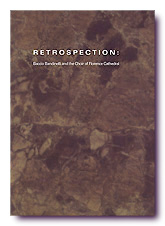Retrospection: Baccio Bandinelli and the Choir of Florence Cathedral
 During the summer of 1995, the Graduate School of Design was invited to participate in the celebrations for the 700th anniversary of the foundation of Florence Cathedral (1296-1996) through a reconstruction of Baccio Bandinelli’s choir and high altar, designed in 1547 and largely dismantled in 1842. It was felt that the importance of visualizing the effect of this enormous marble structure was great: occupying most of the crossing beneath Brunelleschi’s dome, it acted as a visual fulcrum for the four spatial volumes of nave and tribunes, relating these to the vast opening of the dome. Enclosing the most sacred space of the building around the high altar, the choir accommodated the most important liturgical actions of the archbishop, cathedral clergy, canons and choir as well as state ceremonies under the Medici Grand Dukes. To be able to see the choir reconstructed would be essential for an understanding of how the cathedral structure, complete in 1436, was optically unified and focused at the location of its highest function: the pontifical Mass. Two methodological assumptions guided our project from the beginning. First, although we consider the choir as an art object, we focus on the choir and high altar as liturgical furniture. Second, we see the choir as the last in a series of solutions to similar liturgical problems, beginning with the first building on the site, Early Christian Sta. Reparata.
During the summer of 1995, the Graduate School of Design was invited to participate in the celebrations for the 700th anniversary of the foundation of Florence Cathedral (1296-1996) through a reconstruction of Baccio Bandinelli’s choir and high altar, designed in 1547 and largely dismantled in 1842. It was felt that the importance of visualizing the effect of this enormous marble structure was great: occupying most of the crossing beneath Brunelleschi’s dome, it acted as a visual fulcrum for the four spatial volumes of nave and tribunes, relating these to the vast opening of the dome. Enclosing the most sacred space of the building around the high altar, the choir accommodated the most important liturgical actions of the archbishop, cathedral clergy, canons and choir as well as state ceremonies under the Medici Grand Dukes. To be able to see the choir reconstructed would be essential for an understanding of how the cathedral structure, complete in 1436, was optically unified and focused at the location of its highest function: the pontifical Mass. Two methodological assumptions guided our project from the beginning. First, although we consider the choir as an art object, we focus on the choir and high altar as liturgical furniture. Second, we see the choir as the last in a series of solutions to similar liturgical problems, beginning with the first building on the site, Early Christian Sta. Reparata.
The title of our exhibit, “Retrospection: Baccio Bandinelli’s Choir for Florence Cathedral,” finds its most immediate explanation in these assumptions. Our point of view, quite literally, in the historical reconstructions and in the computer visualization, is that of the celebrant at the Mass. Thus, instead of looking from the nave towards the high altar as one usually does when representing a church interior, we look back into the nave from a position at the high altar, or even from the sacristy. Moreover, instead of presenting the choir in its 16th-century context, the main thrust of our research has been to compare it with the earlier choir and high altar arrangements of Sta. Reparata (in both its Early Christian and Romanesque states), during the transition from Sta. Reparata to Sta. Maria de Fiore (1358-1436), and with its immediate predecessor designed by Brunelleschi. A third assumption was that since our aim was visualization, we would attempt reconstructions of these various artifacts and even add congregants and clergy to our images, knowing that such explicit and complete historical reconstructions can only be hypotheses, but feeling that the gains of this approach outweighed the riskindeed, certitudeof error in some details. We believe that since the choir is first of all a functional object it had to be reconstructed within a context of use.
Author: Jude LeBlanc
Harvard Graduate School of Design, 1997